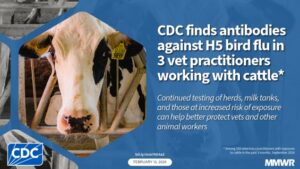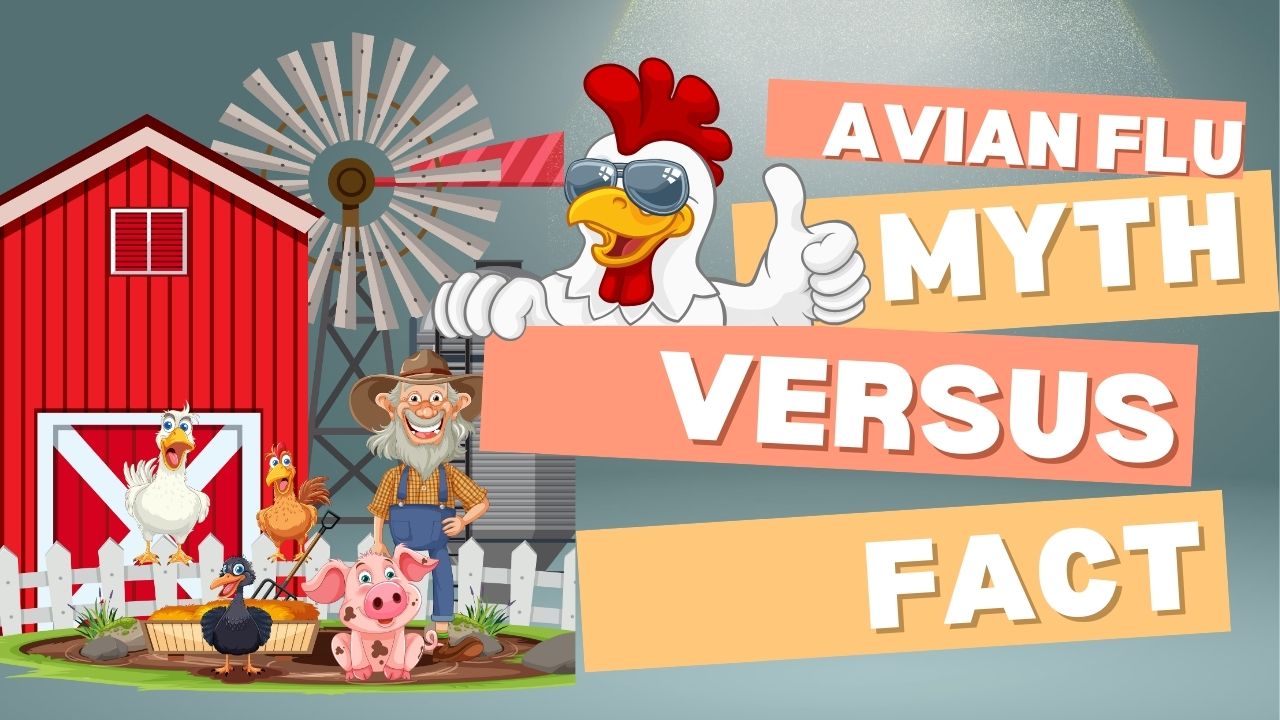Update February 17, 2025 with latest data from CDC
I read this article the other day on Avian Flu in the food supply chain and how it is not harmful to people. That article made front page news on Google and MSN. Yet, what pushed me to the point of the pen was the amount of misinformation documented in the article as fact.
 The point of this blog is not to spread fear, but to spread accurate information so you can make valid decisions about your health. The most important part of health today is having accurate information so you can make reasonable decisions and take reasonable measures based on your value system.
The point of this blog is not to spread fear, but to spread accurate information so you can make valid decisions about your health. The most important part of health today is having accurate information so you can make reasonable decisions and take reasonable measures based on your value system.
Let me share some of the highlights of this article and clarify what science has really said.
“We have already seen milk infected with H5N1, but pasteurization kills the virus. We have not found it in beef, chicken, or eggs,” says Brian Labus, PhD, MPH, REHS
That is entirely false. There are three parts to this statement: pasteurization, infection in humans, and infections in meat.
Let’s look at pasteurization. Pasteurization inactivates the virus. Pasteurization does not kill the virus. There is a difference. We use inactivated viruses in some of our vaccines, including polio, influenza, hepatitis A, and typhoid. At the doses seen in vaccines, the inactivated virus triggers an immune response that usually doesn’t require hospitalization.
So, pasteurization doesn’t kill the virus. It inactivates the virus. It is reasonable to suggest the inactivated virus is able to cause an immune response in our body because some of our vaccines use inactivated viruses. There has been no funding to study whether inactivated avian flu virus can cause an immune response in humans.
What about infections in humans. Forty-one states are testing for Avian Flu in wastewater. Reports from the CDC suggest avian flu virus in wastewater appears to follow infections in cattle herds and not poultry flocks. The CDC has indicated they can’t identify if the avian flu virus is from a human or animal.
California has been testing its wastewater and found H5N1 in the Carson Wastewater Treatment facility on October 28, 2024. This treatment facility covers 50% of Los Angeles County. A week later, the virus was found in the wastewater treatment facilities of San José, Redwood City, San Francisco, Palo Alto, Sacramento, Santa Cruz, Marina and Turlock.
California is at the forefront of the Avian Flu epidemic in cattle with over 400 herds infected. California detected its first case of Avian Flu in cattle on August 30, 2024 in central California. Two months later, the Avian Flu virus was found in the central California Wastewater facility. Less than a week after that, it was detected in much of the wastewater of Northern California.
Talking to someone who recently returned from Central California,
“Everyone is sick down there. Everyone is coughing and congested.”
 What about having contaminated meat in our food supply? Regarding beef, the Dairy Industry has taken point on how this virus is handled in our food supply. They pushed the USDA to agree to work with the Dairy Industry when finding a sick carcass at slaughter. We have done ZERO science on the effect of eating beef contaminated with Avian Flu. So, the Dairy and Cattle Industry can say there is no proof feeding meat contaminated with Avian Flu is dangerous to humans, and in this case, the USDA agrees.
What about having contaminated meat in our food supply? Regarding beef, the Dairy Industry has taken point on how this virus is handled in our food supply. They pushed the USDA to agree to work with the Dairy Industry when finding a sick carcass at slaughter. We have done ZERO science on the effect of eating beef contaminated with Avian Flu. So, the Dairy and Cattle Industry can say there is no proof feeding meat contaminated with Avian Flu is dangerous to humans, and in this case, the USDA agrees.
According to the poultry industry and the veterinary associations, cattle farmers are quickly sending ill cattle to slaughter, risking transmission to other farms, especially poultry farms.
Going back to the article that started this blog,
“The onset of H5N1 is so fast that Labus says that infected birds do not have enough time to lay eggs before the symptoms become fatal.”
Well, not that fast. We have two cat food recalls in Nov and Dec of 2024 for being contaminated with Avian Flu. The food killed cats who ate the food. Since a hen lays eggs every day, it would seem that bird flu fatality is slow enough to allow the poultry the day or two they need to get to market.
“The CDC argues that there is no evidence that food will transmit H5N1—as long as it’s cooked and handled properly.”
That is only because we haven’t done any real science on this. Cornell University published a perspective stating the infectious dose of avian flu in humans through the consumption of infected products is currently unknown, and transmission through oral consumption has been proven in animal models.
The only science that happened at the beginning of the outbreak was testing of raw milk for the virus, which identified that 20% of our commercial milk supply infected with Avian Flu. At that time, when they found the virus in milk, the USDA only tested to see if they thought the virus was inactivated. They never tested the impact on human health.
“Although H5N1 can potentially be found in our food, influenza isn’t really a foodborne disease. You have to breathe it in to get sick, not eat it,” Labus explains. “
That’s true of the normal flu, but not Avian Flu. The transmission into mammals is from consumption of infected meat. The dead cats are dead from consumption of infected meat.
When Avian Flu first jumped into cattle, the U.S. practice of feeding poultry manure to cattle may have been the cause because chicken manure transmits live viruses. That conversation was squashed within a couple weeks.
I know, feeding poultry manure sounds crazy and we are the only country that does this, but we also are the only country with Avian Flu in cattle. If you want more information on The History of Feeding Poultry Manure to Cattle in the U.S., you can click here.
The government was not able to verify the hypothesis the original infection came from poultry manure because the dairy industry, Texas officials, and Texas vets closed ranks. The USDA has been a willing player in this whole tragedy and quickly backed off, allowing the Dairy Industry to take the lead on handling the infection.
 Poultry manure is suppose to be heated – similar to pasteurization – before feeding to livestock. That may have weakened the virus, maybe even inactivated the virus. Yet, even as a weaker virus, the cattle industry’s latest statistics indicate a 2-5% mortality rate in cattle and a permanent 20% reduction in milk production. So, not harmless to health even when a weaker virus.
Poultry manure is suppose to be heated – similar to pasteurization – before feeding to livestock. That may have weakened the virus, maybe even inactivated the virus. Yet, even as a weaker virus, the cattle industry’s latest statistics indicate a 2-5% mortality rate in cattle and a permanent 20% reduction in milk production. So, not harmless to health even when a weaker virus.
“Health experts advise fully cooking your eggs and poultry to an internal temperature of 165°F to kill bacteria and viruses, including this strain of avian influenza.”
I’m not positive we’ve done science on this to prove the avian flu virus is killed at 165°F, but I’m positive Avian Flu is in our meat.
Cambodia has proven you can get Avian Flu from eating sick, well cooked chickens.
My decisions? I stopped buying sale meats, especially sale hamburgers. I used to think sale hamburgers were the same as non-sale hamburgers. It’s not. Beef carcasses are rated at slaughter. More damaged or lower quality carcasses sell at lower values. I believe that sale meat is lower value carcasses like sick animals.
I’m not buying raw milk and not buying milk that comes from California farms.
I don’t know if this is enough to help protect my health. Sometime in October or November of 2024, the USDA underwent a reorganization. That reorganization was probably wholly based on the USDA’s lack of response to the Avian Flu epidemic in cattle. With that change, the USDA started taking more measures to protect our food supply. Yet, with the upcoming change in administration, we’ll have to see what happens, as most of the new Farm Service Directors appointees in the USDA will be cattle farmers.
Updated February 17, 2025
 All reporting from the CDC had been ordered to stop since January 20, 2025. In the first scientific report published by the CDC on February 13th, the CDC notes that avian flu is spreading undetected in people.
All reporting from the CDC had been ordered to stop since January 20, 2025. In the first scientific report published by the CDC on February 13th, the CDC notes that avian flu is spreading undetected in people.
-CDC
This may suggest there are avian flu positive cattle who are slipping through the lack of surveillance. It could mean our food supply may be a source of avian food infection. If the report is no longer accessable through the above link, it can be accessed by clicking here: CDC Report on Avian Flu in Humans not exposed to livestock

